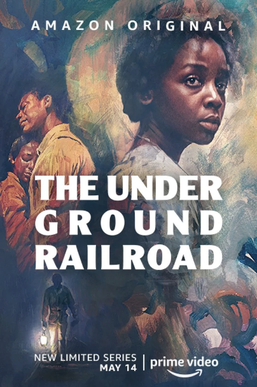“Underground Railroad”–Tracking US History

Based upon the Pulitzer-winning novel by Colson Whitehead, Underground Railroad, is produced and directed by Barry Jenkins (“Moonlighting”). This gripping portrayal is an allegorical account of slavery and the role it has played in American history from colonial times.
The Underground Railroad, in the mid-1800s, was actually a network of safe houses and routes from the southern US up into Canada– with other routes to Mexico (which had abolished slavery decades earlier). The book and film re-imagine these escape routes and safe havens as an actual train running underground to assist runaway slaves in their escape from their plantation owners.
A young slave, Cora Randall (the astounding South African newcomer, Thuso Mbedu) suffers one heartbreaking loss after another–of her mother, beloved friends, and two lovers. In an act of desperation, she tries to escape a Georgia plantation and discovers the Underground Railroad.
In spite of almost insurmountable obstacles and defeats, she triumphs– somewhat miraculously– first, over her slave owner, and then over a notorious and avaricious “slave catcher” with a demented, damaged soul (the excellent Joel Edgerton), and somewhat surprisingly, over a free-state town council. Cora is compelled to run for her life over and over again.
Overlaid with magical realism evoking uncanny spiritual powers, the Black communities, depicted as Valentine Hill (echoing the Greenwood “Black Wall Street” in Tulsa, Oklahoma) have a strength, which their white neighbors fear, yet deny.
This is a must-see film. It is a history lesson for us all. Underground Railroad reveals, through imagery and drama, why so many state governments try so hard to ban “critical race theory” from schools. Perhaps the most disheartening conclusion from watching this masterpiece of visual storytelling, is that the behaviors of those in power back then are so recognizable today.
The viewer needs to have time to feel the raw and brutal emotional truths of those who are trapped and powerless, as well as those who are detached and power-drunk. The outrage and resentment are brilliantly acted by the main characters to deepen the dramatic effect.
Central to the story is the examination of trust and resilience, dependency and the disingenuous guises of the powerful. While the psychology of domination and subjugation are unforgettably rendered, the stunning genius and poetry of the cinematic art form need to be mentioned as well. The cinematography is impeccable. Watch the photographer’s use of light–some scenes yield extraordinary photographs as works of art. The lighting is masterful and exceptional.
Criticism, on some of the major internet movie sites–of the darkness of some scenes– misses the point. Dark tones are intentional, underscoring the underbelly and darkness of US slavery. Yet accompanying slivers of light reveal an ineffable quality of heroism and a tentative optimism.
Needless to say, this is not a movie to binge watch. It is too overwhelming. But the feelings you have after watching each single episode are, in part, because of the quality of the art.
The subject matter is immeasurably uncomfortable because of its closeness to all of us. It is a time for reckoning. That in itself may feel menacing.
If you want to know about the burden of America –without any tone of preaching or lecturing,– watch this masterpiece!
Availability: Amazon Prime

lenore gay
Don’t think I saw this movie. But think I read this Colson Whitehead book. I think two books. Whitehead’s a fine writer! Thank you.
I’m back to working on Sharp&Sabine after a break to send out the wizard book. Sent to several publishers but no idea my
chances.
Hope all’s well with you!
Cheers,
Lenore